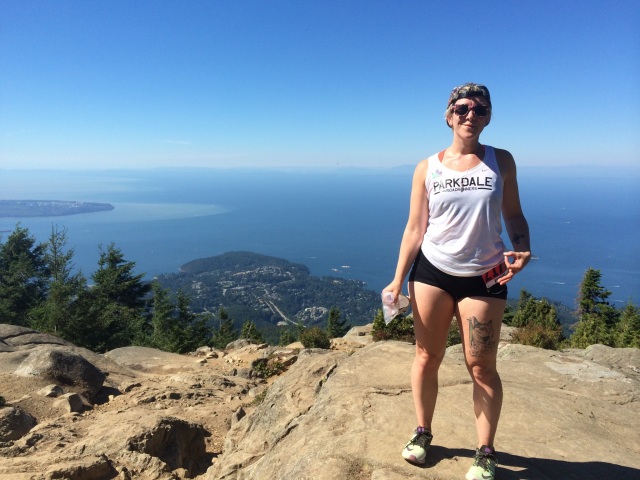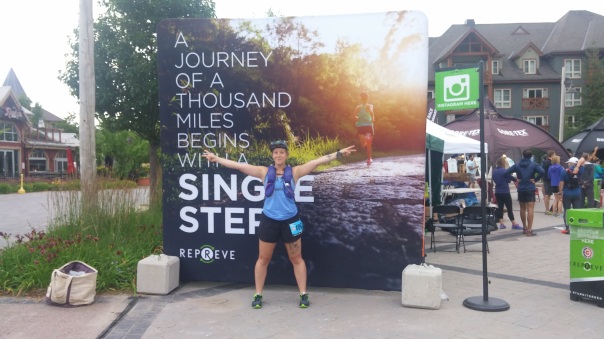
I know, I know. We get it, Altaira! You ran an ultramarathon. What do you want, another fucking medal? Why do you keep writing posts about it? Also, we know that you run! Congratulations! Why not write about something else maybe? I will soon, I promise! But also, get ready for me to probably write about running for roughly half of all future blog posts.
Anyways, after my brief ultra summary post, I also wanted to write a list of lessons learned/general thoughts tips if you’re considering an ultra, or if you’re getting ready to run your first.
- You’re stronger than you think
I know that this one is a cliché at this point, but some clichés become clichés simply because they’re true. With the work and the will, you can become stronger and faster than you’d once imagined, and you can accomplish big goals that you’d never have thought were possible. Running has been an on-again-off-again activity in my life, but when I decided to be on-again in the fall of 2013, I had no idea how integral running would become to my life in the years to come. I remember my first run around Kensington from my first shitty Toronto sublet. I probably only went out for about 5k, and it was slow, and it was painful. I felt heavy and weak. I wasn’t running because I had a goal, or because I loved it; it was simply an inexpensive form of exercise that I had once done, that would be easy to pick up again with no commitment.
One day a friend tagged me in an Instagram post about Parkdale Roadrunnners, and more to make social contact in a new and lonely city than for a dedication to running itself, I became of devout attendee of Tuesday night runs. A way to get fit evolved into a way of life, and the rest is history. Nothing in my life has ever given me the sense of my own strength both physically and mentally that running has. It has left me forever changed, and I imagine that there are many more changes yet to come.
- Test your gear
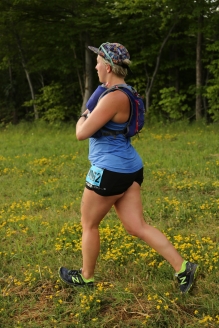 This might sound like some serious “no shit” advice, but it really can’t be emphasized enough. TEST. YOUR. GEAR. When I ordered my running vest, I followed the sizing guide, and it seemed just fine when I put it on unloaded. But 5 blocks into running with the water bottles filled, and I knew that it was all wrong; I traded it in for a smaller size later that day. If I’d waited until race day to try it out, my vest would have been an excruciating burden, instead of a source of support. Also, remember that something that feels mildly annoying over a distance of 5k will become a colossal pain in your ass over a 6+ hour run. Make sure that you’re comfortable going out, you’ll experience enough discomfort without adding unneeded chafing and blisters into the mix.
This might sound like some serious “no shit” advice, but it really can’t be emphasized enough. TEST. YOUR. GEAR. When I ordered my running vest, I followed the sizing guide, and it seemed just fine when I put it on unloaded. But 5 blocks into running with the water bottles filled, and I knew that it was all wrong; I traded it in for a smaller size later that day. If I’d waited until race day to try it out, my vest would have been an excruciating burden, instead of a source of support. Also, remember that something that feels mildly annoying over a distance of 5k will become a colossal pain in your ass over a 6+ hour run. Make sure that you’re comfortable going out, you’ll experience enough discomfort without adding unneeded chafing and blisters into the mix.
- Read about running
This might not be a thing for everyone, but it was immensely helpful for me. I’d never really read much about running before, but in the 6 months leading up to my ultramarathon, I got into running lit. The four that I read were, What I talk about when I talk about running by Haruki Mirakami; Eat and run: My unlikely journey to ultramarathon greatness by Scott Jurek; Older, Faster, Stronger: What women runners can teach us all about living younger, longer by Margaret Webb; and Marathon Woman by Kathrine Switzer. By reading about their experiences, these runners got inside my head, and they got under my skin, in the absolute best way possible. When I felt like I didn’t have more left to give, their stories would come back to me. Their will to go on and overcome their own limitations, helped me to push myself that extra step to overcome mine. If books aren’t your thing, there’s also no lack of blog posts and articles about running out there. Other people’s stories can give you that extra bit of inspiration you need to try something new, to believe in yourself, and to keep going.
- Read about your race
 Yes, road race courses vary. But trail races vary a lot more. Is the trail “technical”? How? What time of year is it? Will the course be slippery? Will part of the race be run in the dark? Do you need to learn about trail markers? Is part of the course single track? All of this information will affect how you train, but it will also strongly affect your gear; especially your shoes! While road shoes might be fine if the course is mostly packed dirt, you might risk injury if you don’t choose more rugged shoes for a trail that involves a lot of rocks, roots, and steeper downhills, particularly if the course is wet and slippery. Reviews and the course guide will also tell you how well supported the race is. If it’s 12k between aid stations, then you need to make sure that you’re carrying enough water/electrolytes/gels to make it between stations on your own. You’ll also need to eat real food throughout your ultra, so if you have severe dietary restrictions, you might want to check with race organizers to see what will be available on the day of. If nothing works for you, having a friend meet you at spectator points with a snack, carrying food in your vest, or having a well-stocked drop bag, will be essential. I’d also recommend reading up on trail running etiquette.
Yes, road race courses vary. But trail races vary a lot more. Is the trail “technical”? How? What time of year is it? Will the course be slippery? Will part of the race be run in the dark? Do you need to learn about trail markers? Is part of the course single track? All of this information will affect how you train, but it will also strongly affect your gear; especially your shoes! While road shoes might be fine if the course is mostly packed dirt, you might risk injury if you don’t choose more rugged shoes for a trail that involves a lot of rocks, roots, and steeper downhills, particularly if the course is wet and slippery. Reviews and the course guide will also tell you how well supported the race is. If it’s 12k between aid stations, then you need to make sure that you’re carrying enough water/electrolytes/gels to make it between stations on your own. You’ll also need to eat real food throughout your ultra, so if you have severe dietary restrictions, you might want to check with race organizers to see what will be available on the day of. If nothing works for you, having a friend meet you at spectator points with a snack, carrying food in your vest, or having a well-stocked drop bag, will be essential. I’d also recommend reading up on trail running etiquette.
- Cross train
Cross train. Cross train. Cross train. Months of box jumps and single leg deadlifts didn’t make the uphills on my ultra easy, but it did make them waaaaaaaaaay easier. It also helped me to avoid injury. Trail running is a full body sport, and particularly if you live in a mostly trail- and hill-less city like me, cross training will be your best friend in the lead up to your ultramarathon. Long runs on flat city streets can only take you so far. If your race has a lot of long hills, I would also consider hitting a treadmill on a steep hill setting once a week. Sometimes hill sprints just don’t cut it. If you have easy access to hiking trails, I would also highly recommend doing a big hike every week or so as part of your training. Maybe a no-brainer, but sometimes it’s too easy to just put in the distance and hope for the best on race day.
- Do a sweat rate test
A running friend recommended that I do a sweat rate test, since I’m a heavy sweater, and he suspected that I was drinking too much water. I got lazy and didn’t make time for it in the lead up to my race, and then really regretted it half-way through. I was drinking pretty steadily and feeling good throughout the first half of my ultra. I also made the horrible mistake of taking electrolyte tablets for the first time (SEE NUMBER 2) during my race. At some point my fingers started to swell like little sausages, and I got worried and didn’t know what to do with myself to correct this. Sadly, the aid station attendants were also not well-versed in electrolyte-water balance, and they advised that I just drink more water. I found out later that this is not what I should have done. If I had done a sweat rate test, I would have had a better handle on the situation, and wouldn’t have had to run with a low level of worry and fear of dehydration or hyponatremia.
- Enjoy yourself
As mentioned in my previous post, focusing on the pleasure of running, and of being outside really got me through the pain, exhaustion, and mental resistance to running my ultramarathon. Focusing on the physical beauty of my surroundings took me out of my head, and helped to ground my body in my surroundings. For me, trail running is the ultimate exercise in mindfulness. Notice the colour of the sky, the smell of the dirt and trees, the feeling of the breeze against your skin. Seriously, just taking the time to notice that you are somewhere beautiful will make the whole journey a million times better.
Any advice you wish you’d heard for your first ultra? I’d love to read it in the comments!
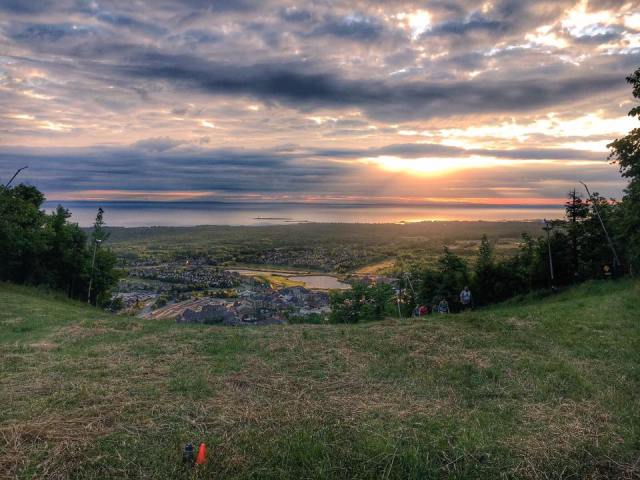 Blue Mountains, Ontario. All photos courtesy of The North Face.
Blue Mountains, Ontario. All photos courtesy of The North Face.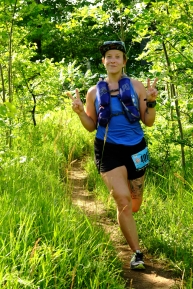 The thing that I have always loved about trail running versus road running is the variety. Instead of a regular and consistent gait, using the same muscles over and over, you are using your whole body to push you up hills, to skip over rocks and roots, to run down mountains. While the distance was a serious challenge, it was this variety in effort and landscape that ultimately kept me going. Over the 50k, there were some seriously steep rolling hills, and challenging forest switchbacks, but there were also beautiful expansive grassy meadows with a single, soft track running down the middle; easy, flat forest trails, with young spry trees forming a light-dappled tunnel of green overhead; and long-stretching lake and valley views.
The thing that I have always loved about trail running versus road running is the variety. Instead of a regular and consistent gait, using the same muscles over and over, you are using your whole body to push you up hills, to skip over rocks and roots, to run down mountains. While the distance was a serious challenge, it was this variety in effort and landscape that ultimately kept me going. Over the 50k, there were some seriously steep rolling hills, and challenging forest switchbacks, but there were also beautiful expansive grassy meadows with a single, soft track running down the middle; easy, flat forest trails, with young spry trees forming a light-dappled tunnel of green overhead; and long-stretching lake and valley views.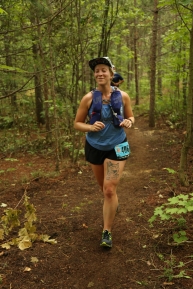 Finding my happy place.
Finding my happy place.